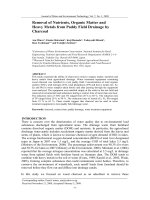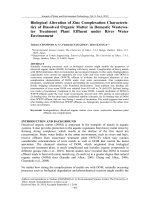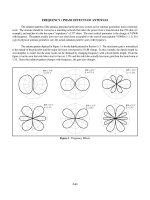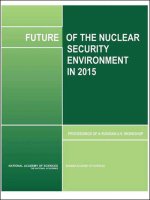Thermodynamic Hadron-Quark Phase Transition of Chiral Nuclear Matter at High Temperature
Bạn đang xem bản rút gọn của tài liệu. Xem và tải ngay bản đầy đủ của tài liệu tại đây (725.61 KB, 9 trang )
Nuclear Science and Technology, Vol.7, No. 1 (2017), pp. 01-09
Thermodynamic Hadron-Quark Phase Transition
of Chiral Nuclear Matter at High Temperature
Nguyen Tuan Anh
Faculty of Energy Technology, Electric Power University,
235 Hoang Quoc Viet, Hanoi, Vietnam
E-mail:
(Received 28 February 2017, accepted 20 April 2017)
Abstract: Based on the extended Nambu-Jona–Lasinio (NJL) model with the scalar-vector eightpoint interaction [15], we consider what ultimately happens to exact chiral nuclear matter as it is
heated. In the realm of very high temperature the fundamental degrees of freedom of the strong
interaction, quarks and gluons, come into play and a transition from nuclear matter consisting of
confined baryons and mesons to a state with ‘liberated’ quarks and gluons is expected. In this
paper, the hadron-quark phase transition occurs above a limited temperature and after the chiral phase
transition in the nuclear matter. There is a so-called quarkyonic- like phase, in which the chiral
symmetry is restored but the elementary excitation modes are nucleonic at high density, appears just
before deconfinement.
PACS: 21.65.-f, 21.65.Mn, 11.30.Rd, 12.39.Ba, 25.75.Nq, 68.35.Rh.
Keywords: Nuclear matter, Equations of state of nuclear matter, Chiral symmetries, Bag model,
Quark-gluon plasma, Quark deconfinement, Equilibrium properties near critical points, Phase
transitions and critical phenomena.
I. INTRODUCTION
The confinement mechanism is an
intrinsic property of quantum chromodynamics
(QCD) - the fundamental theory of the strong
interaction [1]. As very large temperatures, the
interactions which confine quarks and gluons
inside hadrons should become sufficiently weak
to release them [2]. The phase where quarks
and gluons are deconfined is termed the quarkgluon plasma (QGP). Lattice QCD calculations
have established the existence of such a phase
of strongly interacting matter at temperatures
larger than ∼ 170 MeV. There have been
proposed and discussed various types of
scenario concerned with the hadron-quark
deconfinement transitions at high-density and
high-temperature regions, but it is still unclear,
even, whether the phase transition is the cross
over or the first order [3]. Only assumption in
this paper is that the phase transition is of the
first order as suggested by many model studies
[4] and ours [15]. One of the direct
consequences of this assumption is the
emergence of the hadron-quark (HQ) mixed
phase during the phase transition.
The transition between confinement and
deconfinement is of the phase transition
between hadronic and quark-gluon matters.
Theoretical studies of the hadron-quark phase
transition and/or the phase diagram on the
temperature- chemical potential plane for
quark-hadron many-body systems at finite
temperature and density are the most recent
interests. In these extremely hot and/or dense
environment for quark-hadron systems, there
may exist various possible phases with rich
symmetry breaking pattern [3]. The extremely
high density and/or temperature system which
is reproduced experimentally by the relativistic
heavy ion collisions (RHIC) has been examined
theoretically by the first principle lattice
calculations. In the finite density system,
©2017 Vietnam Atomic Energy Society and Vietnam Atomic Energy Institute
THERMODYNAMIC HADRON-QUARK PHASE TRANSITION OF CHIRAL NUCLEAR MATTER…
however, the lattice QCD simulation is not
straightforwardly feasible due to the so-called
sign problem, namely, it is difficult to
understand directly from QCD at finite density.
Thus, the effective model based on QCD can be
a useful tool to deal with finite density system.
By using the various effective models, the
chiral phase transition has been often
investigated at finite temperature and density.
However, it is still difficult to derive the
definite results on the quark-hadron phase
transition due to the quark confinement on the
hadron side.
symmetry. However, if the scalar-vector and
isoscalar-vector eight-point interactions are
introduced holding the chiral symmetry in the
original NJL model, the nuclear saturation
property is well reproduced [13] where the
nucleon is treated as a fundamental fermion.
Recently, we reconsidered the possibility of
using an extended version of the NJL model
including in addition a scalar-vector interaction
in order to describe chiral nuclear matter at
finite temperature and the phase structures of
the liquid-gas transition [14] and chiral
transition [15]. This ENJL (Extended NambuJona–Lasinio)version reproduces well the
observed saturation properties of nuclear matter
such as equilibrium density, binding energy,
compression modulus, and nucleon effective
mass at ρB = ρ0. It reveals a first-order phase
transition of the liquid-gas type occurring at
subsaturated densities; such a transition is
present in any realistic model of nuclear matter;
The model [15] predicts a restoration of chiral
symmetry at high baryon densities, ρ B ≥ 2.2 ρ 0
for T ≤ 171 MeV, and at high temperatures T
> 171 MeV for ρ B < 2.2 ρ 0 .
For the symmetric nuclear matter, it is
important to describe the properties of nuclear
saturation and chiral symmetry restoration. The
Walecka model [5] has succeeded in describing
the saturation property of symmetric nuclear
matter as a relativistic system. The underlying
microscopic mechanism for saturation is a
competition between attractive and repulsive
forces among nucleons, with the attraction
winning at this particular value of the baryon
density. Although this model has given many
successful results for nuclei and nuclear matter,
this model at first stage has no chiral symmetry
which plays an important role in QCD. The
NJL model [6] is one of the useful effective
models of QCD. The celebrated NJL model [6]
gives many important results for hadronic
world [7] based on the concepts of the chiral
symmetry and the dynamical chiral symmetry
breaking. This model has been applied to the
investigation of the dense quark matter [8].
Also, by using this model, the stability of
nuclear matter, as well as quark matter, was
investigated in which the nucleon is constructed
from the viewpoint of quark-diquark picture
[9], and beyond main-field theory [10, 11, 12].
On the other hand, it is known that, if the
nucleon field is regarded as a fundamental
fermion field, not composite one, the nuclear
saturation property cannot be reproduced
starting from the original NJL model with chiral
For the quark-gluon matter, we use the
effective models of QCD such as the MIT
(Massachusetts Institute of Technology) bag
model or the NJL model for quark matter have
been actively done instead. We, hereafter, use
the MIT bag model for simplicity. The QCD
undergoes a phase transition at high
temperatures, to the so-called quark-gluon
plasma phase. By studying how hadrons melt
we may learn more about their structure. So,
hadrons have to be melted first, before filling
the space with thermal quarks and gluons.
In this paper, the nuclear matter
equations of state used in [15] featured a first
order phase transition at high temperatures
between hadronic matter, described by
phenomenological equations of state, and the
quark-gluon plasma (QGP), described by the
2
NGUYEN TUAN ANH et al.
MIT bag model. We then construct a nuclear
matter EoS (Equations of State) similar to that
of Ref. [15] in equilibrium with the MIT bag
EoS [16] for the QGP phase at high
temperatures. In the high-temperature results, it
is expected that a quark-hadron phase transition
occurs after the chiral symmetry restoration in
nuclear matter.
In the mean-field approximation, the σ
(scalar), π (iso-scalar), ω (vector), and ϕ (isovector) fields have the ground state expectation
values
This paper is organized as follows. In the
next section, we briefly recapitulate the
extended NJL model at finite temperature and
baryon chemical potential for nuclear following
Ref. [15]. In Sec. III, the quark-hadron phase
transition at high temperature is described
based on this model. The last section is devoted
to a summary and concluding remarks.
Hence,
where
II. THE CHIRAL NUCLEAR MATTER
For hadronic matter we use a modification
of the original σ - ω model [5], which was
presented in Ref. [15]. For the original σ - ω
model, the EoS, i.e., the pressure P as a
function of the independent thermodynamical
variables temperature T and baryochemical
potential μ, can be derived from the Lagrangian
employing the meanfield (or Hartree, or oneloop) approximation of quantum many-body
theory at finite temperature and density.
Based
on
Lagrangian
thermodynamic potential is derived
(4)
the
where
and Nf = 2 for nuclear matter and Nf = 1
for neutron matter.
The ground state of nuclear matter is
determined by the minimum condition
or
where τ = σ/2 with σ Pauli matrices, µ is
the baryon chemical potential, and Gs , Gv and
Gsv are coupling constants.
which is called the gap equation.
In terms of the baryon density
At nuclear scale, fermion interactions are
in bound states as so-called bosonization,
the EoS read
yielding
3
THERMODYNAMIC HADRON-QUARK PHASE TRANSITION OF CHIRAL NUCLEAR MATTER…
The phase diagram of the two features is
displayed in Figure 2. It displays a clear firstorder liquid-gas transition of symmetric nuclear
matter at subsaturation and a chiral phase
transition of nuclear matter at high baryon
density (with the second-order) or at high
temperature (with the first-order).
The model is able to reproduce wellobserved saturation properties of nuclear matter
such as equilibrium density, binding energy,
compression modulus, and nucleon effective
mass at the saturation density ρB = ρ0. Values
of parameters and physical quantities are given
in Table 1, based on requiring that
with uvac satisfying the gap equation (9)
taken at vacuum, T = 0, and ρB = 0, and
The dependence of the binding energy on
baryon density shows in Figure 1
Fig. 1. (Color online) Nuclear binding energy as a
function of baryon density. The green short dashed,
red long dashed, and blue solid lines are taken from
Refs. [5], [14], and [15], respectively
III. THE HADRON-QUARK PHASE
TRANSITION AT HIGH TEMPERATURE
In this section we discuss the emergence
of the inhomogeneous structure associated with
the hadron-quark deconfinement transition. For
this purpose we need both EOSs of hadron
matter and quark-gluon plasma as realistically
as possible. As we mentioned in the last
section, no one knows how to exactly calculate
the hadron-quark phase transition at high
temperature regions. The studies by using the
effective models of QCD such as the MIT bag
model or the NJL model have been actively
done instead, we here use the MIT bag model
for simplicity.
The model gives two interesting results.
First, it reveals a first-order phase transition of
the liquid-gas type occurring at subsaturated
densities, starting from T = 0, μB ≈ 923 MeV
and extending to a crossover critical end point
(CEP) at T ≈ 18 MeV, μB ≈ 922 MeV. Second,
the model predicts an exact restoration of chiral
symmetry at high baryon densities, ρ B ≥ 2.2 ρ 0
for 0 ≤ T ≤ 171 MeV and μB ≥ 980 MeV, or at
high temperatures T > 171 MeV for μB ≤ 980
MeV and ρ B < 2.2 ρ 0 .
In the (T, μB) plane a second-order chiral
phase transition occurs at T = 0, μB ≈ 980 MeV
and extends to a tricritical point CP at T ≈ 171
MeV, μB ≈ 980 MeV, signaling the onset of a
first-order phase transition for T ≥ 171 MeV.
A. Hadron phase at chiral limit and high
temperature
We now study the chiral phase transitions
at high temperature. Form the phase diagram
(Fig. 2) and ρ B dependence of the chiral
4
NGUYEN TUAN ANH et al.
condensate (Fig. 3), we realize that the chiral
phase transition at high temperature is the firstorder and above T ≈ 171 MeV. For example at
T = 190 MeV, the shadow region shows that
the chiral condensate is a multivalued function
and that it is a mixture state of hot nuclear
phase and hot chiral phase.
Hence,
the
integral
terms
in
thermodynamic potential, gap equation, baryon
density, energy density and EoS can be expand
about chiral limit. Thus, Eqs. (9), (10), (11),
and (12) lead
The Figs. 2 and 3 show that when T >
171 MeV the chiral condensate can be dropped
to zero even at very small values of the
chemical potential and/or baryon density. This
is suggested that, when matter is sufficiently
heated, hadrons become massless and begin to
overlap and quarks and gluons can travel freely
over large space-time distances. Within this
picture, T ≈ 171 MeV is the limiting
temperature for the deconfinement phase
transition between hadrons and quarks and
gluons, that we may call the chiral limit.
Fig. 2. (Color online) The phase transitions of the
chiral nuclear matter in the (T, μB) plane. The solid
line means a first-order phase transition. CEP (T ≈
18 MeV, μB ≈ 922 MeV) is the critical end point.
The dashed line denotes a second-order transition.
CP (T ≈ 171 MeV, μB ≈ 980 MeV) is the tricritical
point, where the line of first-order chiral phase
transition meets the line of second-order phase
transition. The shadow region is the emergence of
hadron-quark mixed phases during the hot chiral
phase transition.
At high temperature where the chiral
symmetry is restored and nucleons become
deconfinement, this transition is the so-called
quark-hadron transition. Even when the netbaryon number density is small, nuclear matter
consists not only of nucleons but also of other,
thermally excited hadrons, the lightest hadrons,
the pions, are most abundant, the typical
momentum scale for scattering events between
hadrons is set by the temperature T. If the
temperature is on the order of or larger than
ΛQCD, scattering between hadrons starts to
probe
their
quark-gluon
substructure.
Moreover, since the particle density in- creases
with the temperature, the hadronic wave
functions will start to overlap for large
Fig. 3. (Color online) The ρ B dependence of the
chiral condensate at various values of T. For
example at T = 190 MeV, the shadow region shows
that there exits a mixture state of hot nuclear phase
and hot chiral phase.
5
THERMODYNAMIC HADRON-QUARK PHASE TRANSITION OF CHIRAL NUCLEAR MATTER…
temperatures. Consequently, above a certain
temperature one expects a description of
nuclear matter in terms of quark and gluon
degrees of freedom to be more appropriate.
solar masses. Indeed, the maximum mass
increases as the value of B decreases, but too
small values of B are incompatible with a
hadron-quark transition density ρB > 2-3 ρ0 in
nearly symmetric nuclear matter, as demanded
by heavy-ion collision phenomenology.
The picture which emerges from these
considerations is the following: for very small
baryon chemical potentials μB ~ 0, the limiting
temperature for hadron-quark phase transition
from nuclear matter is a gas of hadrons to
plasma of quarks and gluons, corresponding to
P ≥ 0, reads
In order to overcome these restrictions of
the model, one can introduce a densitydependent bag parameter B(ρB), and this
approach was followed in Ref. [18]. This
allows one to lower the value of B at large
density (and high temperature), providing a
stiffer QGP EoS and increasing the value of the
maximum mass, while at the same time still
fulfilling the condition of no phase transition
below ρB ≈ 2 ρ0 in symmetric matter. In the
following we present results based on the MIT
model using a gaussian parametrization for the
density dependence,
B. Quark phase
For the quark phase we employ the
standard MIT bag model [16] for massless,
non-interacting gluons and u, d quarks. At high
temperature EoS of quark-gluon plasma is
obtained, i.e.,
with β = 0.17.
and other quantities
The limiting temperature for hadronquark phase transition, corresponding to P ≥ 0,
reads
Here, a baryon consists of three quarks,
ρB = ρq/3 and μB = 3μq. To the factor 37 = 16 +
21, 16 gluonic (8 × 2), 12 quark (3 × 2 × 2) and
12 antiquark degrees of freedom contribute,
with assuming that only up and down flavors
contribute significantly to the quark pressure.
The properties of the physical vacuum are taken
into account by the bag parameter B, which is a
measure for the energy density of the vacuum.
Comparing this equation to (19), we get
The value of B∞ is fixed at the tricritical
point (T ≈ 171 MeV, μB ≈ 980 MeV). It gives
The range of the bag parameters B is
found from B 1/4 = 125 MeV to about 300 MeV
which is consistent with the results from a bag
model analysis of hadron spectroscopy [19].
It has been found [17] that within the
MIT
bag
model
(without
color
superconductivity) with a density-independent
bag constant B, the maximum mass of a
neutron star cannot exceed a value of about 1.6
The hadron-quark transition at very high
6
NGUYEN TUAN ANH et al.
temperature provides the following picture:
when matter is heated, nuclei eventually
dissolve into protons and neutrons (nucleons).
At the same time light hadrons (preferentially
pions) are created thermally, which increasingly
fill the space between the nucleons. Because of
their finite spatial extent the pions and other
thermally produced hadrons begin to overlap
with each other and with the bags of the
original nucleons such that a network of zones
with quarks, antiquarks and gluons is formed.
At a certain critical temperature Tc these zones
fill the entire volume in a percolation transition.
This new state of matter is the quark-gluon
plasma (QGP). The vacuum becomes trivial and
the elementary constituents are weakly
interacting. There is, however, a fundamental
difference to ordinary electromagnetic plasmas
in which the transition is caused by ionization
and therefore gradual. Because of confinement
there can be no liberation of quarks and
radiation of gluons below the critical
temperature. Thus a relatively sharp transition
is expected.
Which leads to a phase boundary curve
T (μ ) in the T - µ plane defined by the implicit
equation PHD(T*, μ*) = PQGP(T*, μ*), see Fig. 4.
The phase transition constructed via (27) is of
first order for T > 171 MeV, leading to a
mixed phase of QGP and hadron matter.
*
*
Fig. 4. (Color online) The hadron-quark phase
transitions (blue dot-dashed line) of the hot chiral
nuclear matter to quark-gluon plasma in the (T, µB)
plane. The shadow region is the emergence of
hadron-quark mixed phases during the hot chiral
phase transition.
Here, it should be noted that the quarkhadron phase transition happens above a limited
temperature, so there is a region outside chiral
symmetry restoration and below the limited
temperature, i.e. occurs at densities greater than
that for the chiral transition. This suggests that a
phase that is chiral symmetric but confined with
nucleonic (hadronic) elementary excitation
could exist just before the phase transition from
the nuclear phase to the quark one. Recently,
McLerran and Pisarski have proposed a new
state of matter, the so-called quarkyonic matter
[21], which is a phase characterized by chiral
symmetry restoration and confinement based on
large Nc arguments. The name ‘quarkyonic’
expresses the fact that the matter is composed
of confined baryons yet behaves like chirally
symmetric quarks at high densities. There may
be non- perturbative effects associated with
confinement and chiral symmetry restoration
near the fermi surface, since there the
interactions are sensitive to long distance
In the MIT-Bag model thermodynamic
quantities such as energy density and pressure
can be calculated as a function of temperature
and quark chemical potential (or baryon
chemical potential) and the phase transition is
inferred via the Gibbs construction of the phase
boundary. By construction, the hadron- quark
transition in the MIT bag model is of first order,
implying that the phase boundary is obtained by
the requirement that, at constant chemical
potential, the pressure of the QGP is equal to
that in the hadronic phase.
C. Phase equilibrium
The QGP EoS (20) is matched to the
hadronic EoS (18) via Gibbs conditions for
(mechanical, thermal, and chemical) phase
equilibrium [20],
7
THERMODYNAMIC HADRON-QUARK PHASE TRANSITION OF CHIRAL NUCLEAR MATTER…
effects, but the bulk properties should look like
almost free quarks.
quark phase side. Further, it is widely believed
that neutron star matter undergoes a phase
transition to quark-gluon plasma at high
temperature and/or density. Thus, it is also
interesting to investigate the phase transition
between neutron star matter and quark matter.
This leads to the understanding and
development of the physics of neutron stars.
As shown in Fig. 4, there are certainly
two phase boundary, one between the hadronic
and quarkyonic phases, and other between the
quarkyonic and deconfined phases with a
tricritical point TCP ≈ 171 MeV. Thus, this
chiral symmetric nuclear phase predicted by our
model may possibly correspond to the
quarkyonic phase.
REFERENCE
[1] D. J. Gross and F. Wilczek, Phys. Rev. Lett. 30
(1973) 1343; H. D. Politzer, Phys. Rev. Lett. 30
(1973) 1346.
IV. CONCLUSION
The hadron-quark phase transition at
very high temperature has been investigated
following Ref. [15] in the extended NJL model
with scalar-vector eight-point interaction. In
this model, as a first attempt to investigate the
hadron- quark phase transition, the hadron side
was regarded as chiral nuclear matter and the
quark side as a quark-gluon plasma with no
quark-pair correlation. Both phases were
matched via Gibbs’ phase equilibrium
conditions for a first order phase transition.
[2] J. C. Collins and M. J. Perry, Phys. Rev. Lett.
34 (1975) 1353
[3] K. Fukushima and T. Hatsuda, Rep. Prog. Phys.
74 (2011), 014001.
[4]
T. Schaefer, arXiv:0509068; P. BraunMunzinger and J. Wambach, Rev. Mod. Phys.
81 (2009) 1031.
[5] B. D. Serot and J. D. Walecka, Advances in
Nuclear Physics, Vol.16, eds. J. W. Negele and
E. Vogt (Plenum, New York, 1986).
There is an interesting phase from the
phase diagram in Fig. 4 lying below the quarkhadron phase transition and occurring after
chiral symmetry restoration in the nuclear
matter. This might appear as an exotic phase,
i.e., the nuclear phase, not the quark phase,
while the chiral symmetry is restored in terms
of the nuclear matter. This phase may possibly
correspond to the quarkyonic phase, which is
introduced as a chiral symmetric confined
matter [21].
[6] Y. Nambu and G. Jona-Lasinio, Phys. Rev.
122 (1961), 345; ibid. 124 (1961), 246.
In this paper, we have ignored the color
superconducting phase which may exist in
finite density systems and relate to quarkyonic
phase. So, the next challenging task may be to
investigate the phases of nuclear matter,
including nuclear super-fluidity and quarkgluon plasma, and also including the color
superconducting state, i.e., nucleon pairing on
the nuclear phase side and quark pairing on the
[11] Tran Huu Phat, Nguyen Tuan Anh, Nguyen
Van Long, and Le Viet Hoa, Phys. Rev. C76
(2007), 045202.
[7] S. P. Klevansky, Rev. Mod. Phys. 64 (1992),
649; T. Hatsuda and T. Ku- nihiro, Phys. Rep.
247 (1994), 221.
[8] M. Buballa, Phys. Rep. 407 (2005), 205.
[9] W. Bentz and A. W. Thomas, Nucl. Phys. A
693 (2001), 138.
[10] Tran Huu Phat, Nguyen Tuan Anh, and Le
Viet Hoa, Nucl. Phys. A772 (2003), c548.
[12] Tran Huu Phat, Nguyen Tuan Anh, and
Nguyen Van Long, Phys. Rev. C77 (2008),
054321.
[13] V. Koch, T. S. Biro, J. Kunz, and U. Mosel,
Phys. Lett. B 185 (1987), 1. [14] Tran Huu
Phat, Nguyen Tuan Anh, and Dinh Thanh Tam,
8
NGUYEN TUAN ANH et al.
Phys. Rev. C84 (2011), 024321.
[19] U. Heinz, P. R. Subramanian, H.St¨ocker, and
W. Greiner, J. Phys. G12 (1986) 1237; J.
Cleymans and E. Suhonen, Z. Phys. C37
(1987) 51; H. Kouno and F. Takagi, Z. Phys.
C42 (1989) 209; B. M. Waldhauser, D. H.
Rischke, J. A. Maruhn, H. St¨ocker, and W.
Greiner, Z. Phys. C43 (1989) 411; Q.-R.
Zhang and H.-M. Liu, Phys. Rev. C46 (1992)
2294; Bo-Qiang Ma, Qi-Ren Zhang, D. H.
Rischke, W. Greiner, Phys. Lett. B315 (1993)
29.
[15] Nguyen Tuan Anh and Dinh Thanh Tam, Phys.
Rev. C84 (2011), 064326. [16] A. Chodos, R.
L. Jaffe, K. Johnson, C. B. Thorn, and V. F.
Weisskopf, Phys. Rev. D9 (1974), 3471.
[17] G. F. Burgio, M. Baldo, P. K. Sahu, A. B.
Santra, and H.-J. Schulze, Phys. Lett. B526
(2002) 19; G. F. Burgio, M. Baldo, P. K.
Sahu, and H.-J. Schulze, Phys. Rev. C66
(2002) 025802.
[18] O. E. Nicotra, M. Baldo, G. F. Burgio, and H.J. Schulze, Phys. Rev. D74 (2006) 123001.
[20] D. H. Rischke, Y. Puersuen, J. A. Maruhn,
Nucl. Phys. A595 (1995) 383; Erratum-ibid.
A596 (1996) 717.
[21] L. McLerran and R. D. Pisarski, Nucl. Phys.
A796 (2007) 83; Y. Hidaka, L. McLerran, and
R. D. Pisarski, Nucl. Phys. A808 (2008) 117; L.
McLerran, K. Redlich, and C. Sasaki, Nucl.
Phys. A824 (2009) 86.
9









